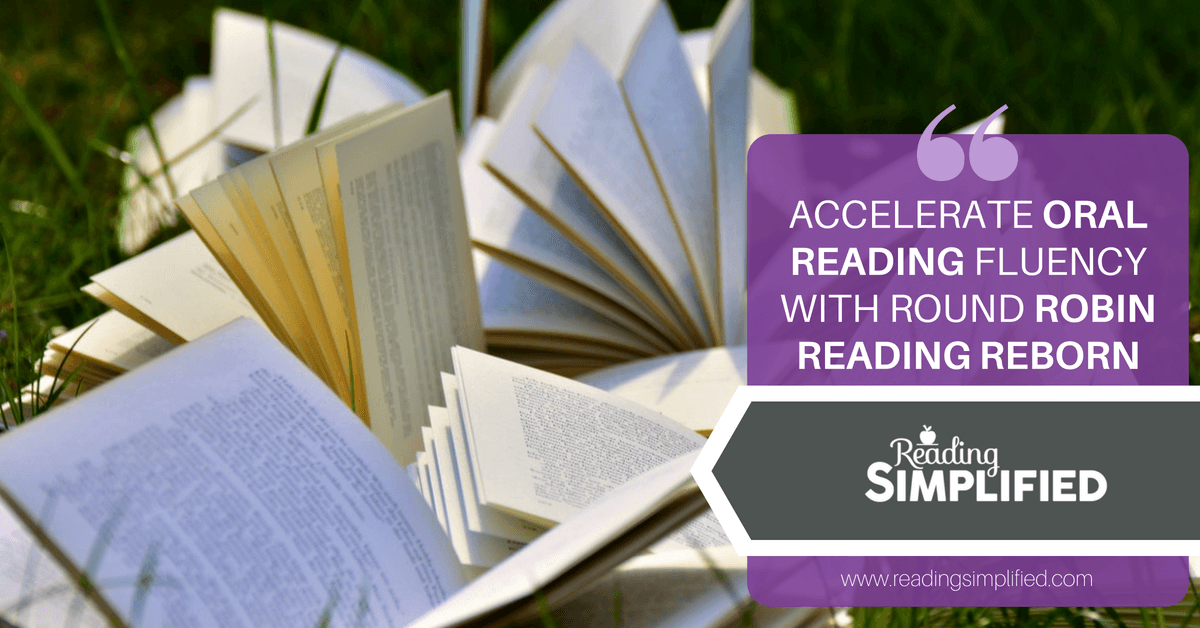Videos About the Importance of Reading for Students
Why practice some kids struggle with reading more than others?
Are they missing something? And if so, what is it?
If you ask me what beginner or struggling readers are neglecting, I'd tell you that it's a lack of oral reading practice with a teacher's feedback.
Strategic oral reading do with a teacher'southward feedback is the NUMBER I fashion to move a struggling reader along the reading achievement scale . It helps develop fluent reading skills and increases comprehension, making it a crucial part of a reader's growth.
But how can nosotros be more than strategic about our guided reading time? And why is it and so important?
{Hit play beneath to watch a video on strategic oral practice or read on for a more detailed overview}
An In-Depth Analysis of Reading Fluency…
Before we get into tips for developing a strategic approach to oral reading practise, let'due south take a await at what the United States' National Reading Panel said well-nigh the relationship between reading fluency and oral reading practice…
The The states' National Reading Console carried out a serial of studies that provided a very persuasive case for oral reading. The findings showed that when kids read out loud multiple times (while receiving guidance and feedback from their teacher), their reading achievement skyrockets.
Repeated oral reading helps struggling and beginner readers…
- Develop reading comprehension skills
- Increase reading fluency
- Speak out loud with speed, accuracy, and proper expression
Equally a reading tutor, I've plant the findings of this study to be 100% accurate.
Struggling readers need reading practice, feedback and rereading exercise to become fluent and better readers.
So, how are you going to squeeze more reading time into your daily routine for struggling readers?
What would you say if I suggested Round Robin Reading REBORN?
Many of u.s. have been told to throw Round Robin Reading out of the classroom window. But what if information technology may be more fitting in a particular context? First though, indeed, there are issues with whole class circular robin reading...
Problems with Circular Robin Reading
Round Robin Reading is when a group of students is asked to read part of text aloud while other students follow along. Yet, it'south been widely discredited because of its long list of "negative traits."
Here are just a few of the problems with Round Robin Reading:
1. Limited do per student
If you're doing Circular Robin Reading with a class of 28 students and each kid takes turns reading, it won't leave much time for quality practise for any one child in particular.
2. It tin can cause embarrassment and boredom
Exercise yous remember doing similar reading activities to Round Robin Reading when you were a child?
The struggling readers felt embarrassed because they couldn't get information technology right and the good readers were bored.
Most kids terminate upward looking out the window, passing notes to their friends or doodling in their notebooks – and who tin can arraign them?
iii. Limited accountability
I of the main problems with this activeness is the fact that doesn't give the students plenty accountability.
They may be listening to the words being read past their peers, but are their eyes on the print ? Or take they zoned out?
Limited accountability tin stunt growth on word identification skills, which is the number one issue for most struggling readers.
4. Limited teacher feedback
With so many students to get through, there's not much fourth dimension for proper feedback. Struggling readers don't go the coaching they need considering there's merely no fourth dimension dedicated for feedback.
Oral Reading: Strategic Routines
I'm suggesting a reading model designed for modest groups that non only saves time but accelerates readers more quickly.
It holds a few similarities to Circular Robin Reading WITHOUT express accountability, limited feedback, and express practice potential.
How does that audio?
Pretty practiced, huh?
I like to call it… Round Robin Reading REBORN
New Oral Reading: Small Homogeneous Groups
When all of the students are on the same reading level, it makes things so much easier.
First, the students accept nothing to feel embarrassed about because they're with students at the aforementioned level.
Secondly, oral reading with a small homogeneous group makes lesson planning a lot easier. Y'all tin prepare in advance and give the students a text that actually meets their private needs.
Oral reading with feedback from the instructor is so of import. And when you lot exercise this activeness with a pocket-sized group, you can ensure that each child reads enough words with quality feedback followed up with some rereading practice.

Here are a few principles that will aid guide a small group reading instructional session:
Match text with word work
Brand certain to match the reading text with any the students are learning or struggling to learn.
And so, if the kids are working on the short vowel "a," choose a text that has the short vowel "a" in a lot of places and so kids can practice their most pressing need.
If you lot want to give your kids more practice with short vowels, here's a short vowel exercise passage you lot can download for FREE!
Each child reads as others follow
Since you're working with a small group, you can keep an eye on each student to make sure they have their optics on print.
Ask the students to follow along with their centers or to use a bookmark to help marker the position on the folio.
The teacher offers individualized feedback
Individualized feedback is then important but when you're working with a larger group of students, devoting fourth dimension to each one of them is virtually impossible. There'south not enough time!
Notwithstanding, with small grouping reading instruction , you lot can offer individualized feedback based on the specific problems each child is facing.
Students chop-chop develop two core decoding strategies.
Strategic oral reading practice with individualized feedback helps kids develop the two core decoding strategies they need to be proficient readers – Blend Equally You Read and Flex Information technology.
You can find out more most these two strategies here: readingsimplified.com/starting time-here
Plough-taking is random
Keep kids on their toes by choosing the next reader at random.
If students don't know who is reading next, they're more likely to follow forth and keep rail in case they are chosen to read out loud.
You tin can make information technology fun by playing a game with the kids. For case, take a joker menu and randomly hand it to one of the students. When a student is given the joker card, they'll know that it's their turn to read aloud.
The teacher holds students accountable
All of these things nosotros've discussed allows the teacher to concord the students accountable to optimizing Eyes on Impress time, which is precisely what y'all want from your small group reading fourth dimension!
The instructor models fluent reading
As the teacher, it's up to you to model fluent reading and so that your students tin follow along when the students read the text for the 2nd time.
This gives them extra do with reduced endeavour, and the repetition helps grade the reading skills they need to advance to the adjacent level.
Students chorally re-read
Choral reading helps to better kid's fluency. In one case each child has read aloud and the teacher has re-read it to the group, take them also do some choral reading with the teacher being most dominant to give them a fluent instance to end the lesson.
Students practice independently
When the lesson has ended, make sure that your students get more practise with contained reading.
Reading independently builds fluency and growth because the kids become more practise with decoding and high-frequency words, leading to vocabulary and reading evolution.
Educatee returns the next mean solar day with mastered text
Keep your students accountable by "testing" them the side by side day.
Spot cheque and mind advisedly to each student to see who is stumbling and who isn't. The ones that struggle volition need more exercise while those that fly through the text can move onto a more difficult passage.
This routine of strategic oral reading principles is the antidote for problems associated with Round Robin Reading!

Source: https://readingsimplified.com/oral-reading-importance/
0 Response to "Videos About the Importance of Reading for Students"
Post a Comment